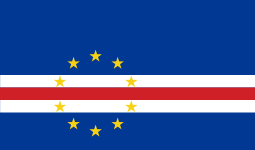The national flag of Cape Verde (bandeira nacional de Cabo Verde) was adopted on 22 September 1992, replacing the flag adopted during independence.
 | |
| Use | National flag and ensign |
|---|---|
| Proportion | 10:17 |
| Adopted | 22 September 1992 |
| Design | Five unequal horizontal bands of blue (6/12), white, red, white (1/12 each) and blue (3/12) with the circle of ten yellow five-pointed stars centered on the red stripe and positioned three-eighths of the length of the flag from the hoist-side. |
Description
editThe flag of Cape Verde has five unequal horizontal bands of blue, white, and red, with a circle of ten yellow five-pointed stars, all pointing upwards. The topmost blue stripe is half the height of the flag. Each of the three stripes of white and red are one twelfth of the height, and the bottom blue stripe is one quarter. Therefore, the height of the stripes are in a 6:1:1:1:3 ratio.
The circle of stars is centered at 3⁄8 of the height from the bottom (which corresponds to the center of the red stripe), and 3⁄8 of the length from the hoist side. The lowest star is inscribed in an invisible circle centered at the middle of the lower blue stripe (that is, one eighth of the height from the bottom). The size of this invisible circle (which determines the size of the stars) is not specified by the constitution, but it is commonly constructed with a diameter equal to 1/12 of the height of the flag, i.e. the same height as the red and white stripes.
Symbolism
editThe 10 stars on the flag represent the main islands of the nation (a chain of islands off the coasts of Senegambia and Mauritania in West Africa). The blue represents the ocean and the sky. The band of white and red represents the road toward the construction of the nation, and its colours stand for peace (white) and effort (red).[1] The circle of yellow stars on a dark blue field is similar to the flag of Europe (which has 12 stars instead of 10).
Proportions
editThe Constitution of the Republic[2] does not specify official proportions for the height and the length of the flag. The dimensions of the parts that make up the flag are given proportionally to the dimensions of the sides, without specifying the side dimensions. However, the proportion most widely used is 2:3,[3] which is the same proportion that was used in the flag prior to 1992. Consequently, both 10:17 and 2:3 are the de facto proportion of the flag.
Colour shades
editThe Boletim Oficial gives the official shades of the flag's colours (as well as the colours of the Arms of the Republic):[4]
| Color | Pantone | Web colors | RGB | CMYK | HSV |
|---|---|---|---|---|---|
| Blue | 287C | 003893 | 0, 56, 147 | 100%, 89%, 8%, 2% | 218.69°, 100%, 55.47% |
| White | White | FFFFFF | 255, 255, 255 | 0%, 0%, 0%, 0% | 0, 0, 100% |
| Red | 186C | CF2027 | 207, 32, 39 | 12%, 100%, 100%, 3% | 347.31°, 98.49%, 80.31% |
| Yellow | 116C | F7D116 | 247, 209, 22 | 4%, 15%, 98%, 0% | 47.74°, 100%, 100% |
The Pantone, CMYK and RGB are official as published in the bulletin. The other colour shades (Web and HSV) are interpretations of the Pantone standards.
History
editBefore independence from Portugal, Cape Verde did not have an official flag, and the Portuguese national flag was used. In the late 1960s, a flag for the Portuguese overseas province of Cape Verde was proposed, consisting of the flag of Portugal with the shield from the provincial arms added to the lower fly. However, this flag was never adopted.
The original national flag of Cape Verde was introduced on independence in 1975 and was based on the flag of the African Party for the Independence of Guinea and Cape Verde (PAIGC). It used the common African colours of red, green and yellow, and was identical to the flag of Guinea-Bissau except for the proportions and the charge in the hoist-side stripe. Their similarity evoked the plans to unite both countries, which were abandoned shortly after independence. Guinea-Bissau gained independence on 10 September 1974.
References
edit- ^ "Bandeira". governo.cv (in Portuguese). Retrieved 12 September 2024.
- ^ "Article 8 of the Constitution of the Republic" (in Portuguese). Archived from the original on 2009-08-12.
- ^ Cape Verde at Flags of the World
- ^ "Boletim Oficial Sumario" (PDF). caboverde.eregulations.org. 2009-12-21.